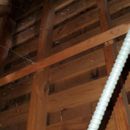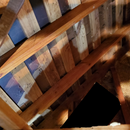What material to put between closed cell spray foam and underside of roof deck (old skip sheathing)
Hello, I am doing a kitchen remodel in a 1939 Cape Cod (1.5 story – cathedral ceilings in 2 upstairs bedrooms and bath) and have an unvented and normally inaccessible attic space open up over the kitchen. After researching here and other places I’ve decided on putting 2″ to 3″ of closed cell spray foam on the underside of my roof deck but want to make sure it lasts through a possible future new roof job in maybe 5-15 years from now.
Current roof (from previous owners) is asphalt shingles over wood shake shingles on top of skip sheathing (1x4s with gaps between them). The roof doesn’t leak and shingles are in very good condition and only ~9 years old.
I fear that the next time a new roof is installed it will destroy the spray foam so I was looking for some kind of solution to possible put between the roof deck underside in between the rafters. Is this neccessary? Are there any products that work well for this, I’ve seen ramboard suggested but didn’t know what else there could be that will hold up well.
Thanks in advance,
Alex
GBA Detail Library
A collection of one thousand construction details organized by climate and house part











Replies
"cut and cobble" foam will work and might be the fastest and easiest.
you could staple in almost anything from insulweb, cheap housewrap, poly, etc.
I wonder if you can "cut and cobble" in a way with rigid board foam as the outermost layer and then add another 2 inches of closed cell spray foam on top and skip out on the "great stuff" canned spray foam. Anyone have experience with closed-cell over rigid foam and any reason not to try that instead of ramboard or some kind of housewrap?
Allowing the non-destructive future replacement of some 1x4s is a good idea. But also note that limited drying trapped air spaces in a roof are a negative - which is why the IRC requires "direct contact with the underside of the structural roof sheathing*". This isn't so easy when adding something under skip sheathing. Perhaps some type of spray on release agent (to minimize foam bonding to the above layers)?
* for various extant reasons, including pumping from barometric, wind and solar effects and the rapid moisture accumulation this causes.
According to your IRC link it says
>3. Where wood shingles or shakes are used, a minimum 1/4-inch (6.4 mm) vented airspace separates the shingles or shakes and the roofing underlayment above the structural sheathing.
What I have (from previous owners) are asphalt shingles on top of wood shake shingles which is on 1x4 skip sheathing. I'm not 100% sure but it sounds like not having direct contact is fine in this situation and either way I'm not sure what the difference would be if it were directly on the skip sheathing and shingles vs on #15 felt that is tight over the sheathing between the rafters .
I am currently leaning towards using 1 inch polyiso rigid foam directly to the skip sheathing and then spraying my closed cell spray foam 2"-3" thick over that which should seal the rigid foam as well as a form of cut and cobble (in order to preserve the insulation whenever the roof is replaced in 10+ years hopefully).
Wood shakes allow lots of drying to the exterior (a flow-through assembly). Which doesn't apply once you put asphalt singles over them. Look at the principles (read the wind link above) and make a reasonable guess at IRC intent, not some strained interpretation of the vague wording. I'd say your shakes are now just a superfluous layer, not "used". Foil faced polyiso will further limit outward drying.
The IRC requires "direct contact" both to reduce convection and air leakage through the insulation, and to prevent unconditioned air from bypassing the insulation and getting between the insulation and the inside of the building shell. Neither of these is an issue at the underside of the roof. In this case, the "direct contact" would be with the housewrap or other material under the skip sheathing. And, with the airspace between furring and the layer of wood shingles, the proposed roof will have significant ability to move moisture laterally to dry out through the very limited permeability of the asphalt shingles. I'd call the air spaces a plus, not a minus.
As mentioned above, you can use pretty much anything on the underside of the skip sheathing. Good old #15 felt paper would be appropriate and very inexpensive. If it were me, I think I'd cut&cobble an inch or two of rigid polyiso foam (recycled if possible), and follow that with another inch or two of closed cell HFO-blown spray foam. In theory you should be aiming for at least current minimum code levels of insulation, and even 2" of polyiso and 2" of CCSPF won't get you there. Much better than nothing, though.
> Good old #15 felt paper would be appropriate and very inexpensive. If it were me, I think I'd cut&cobble an inch or two of rigid polyiso foam (recycled if possible), and follow that with another inch or two of closed cell HFO-blown spray foam
Are you saying you'd use the 15# felt paper and rigid cut and cobble? Also would you seal the rigid foam board with canned spray foam or can I skip that step and seal it with the closed cell HFO foam?
I have used housewrap for this purpose, put up with a stapler. I've only done that in a wall though, to allow for the future replacement of the existing T1-11 without wrecking the spray foam.
Ideally you want something that is spray applied, so that there are no air gaps. It will be nearly impossible to achieve that "no air gaps" part any other way. Any air gaps are at risk of accumulating moisture.
I would try using some incompatible paints together on purpose, to get a sort of peel-off coating. Apply a layer of gloss oil point, let it dry completely, then apply a layer of gloss latex paint over that. Latex paint doesn't stick well to oil paint, so the two layers should seperate without wrecking the spray foam if and when needed. I would absolutely TEST THIS FIRST before doing it on a large scale though. The advantage to using a layered paint setup like this is that there would be no air spaces. If you can't get oil paint, I'd try some of the easy clean baby room paint instead. You want a slick surface that the second layer of paint won't adhere to very well.
Note that this will make the spray foam not be able to be supprted very well from the underside of the roof, so it will need to be supported by the rafters. This might make application more challenging. This would actually be a very interesting expieriment to try, but that's what it is -- I've never tried this myself.
I don't know of any releaseable coatings that will work with spray foam. Spray foam sticks well to everything, it's even stuck to polyethyelene well enough to be a problem.
Bill